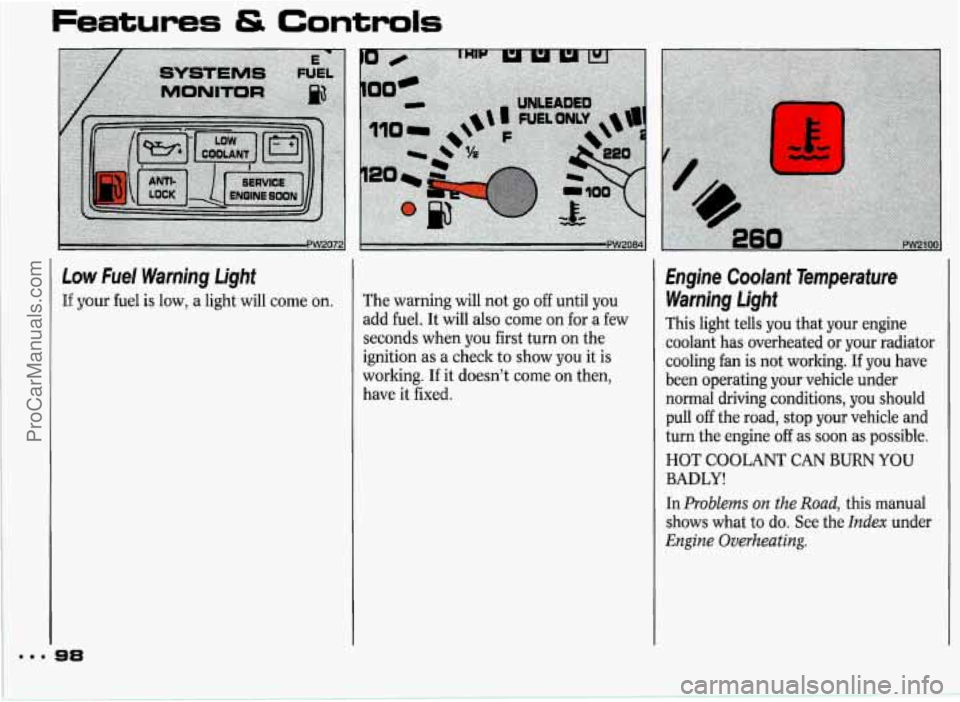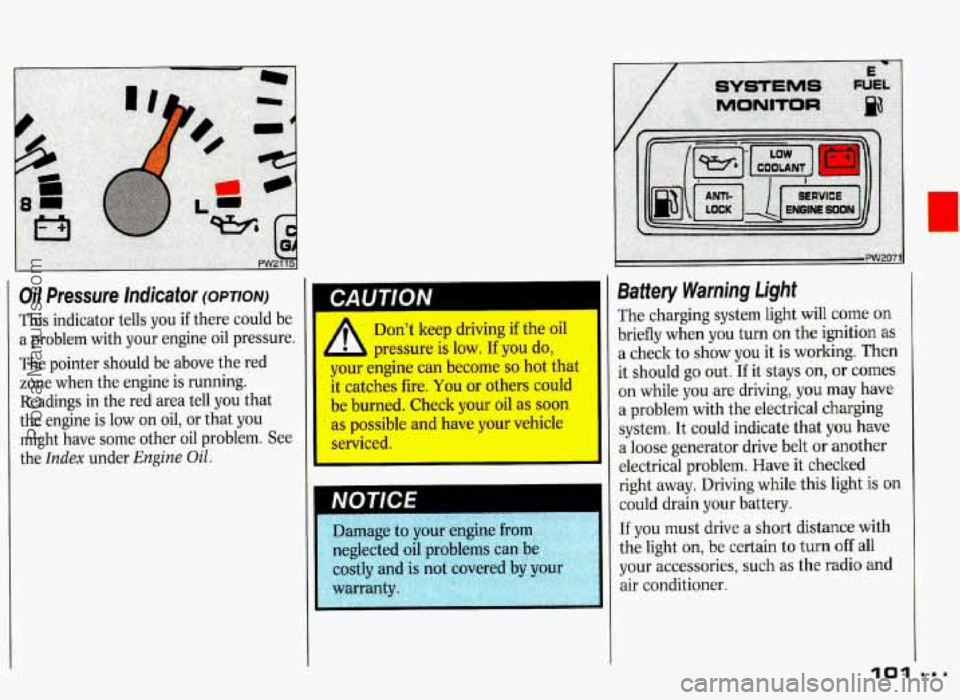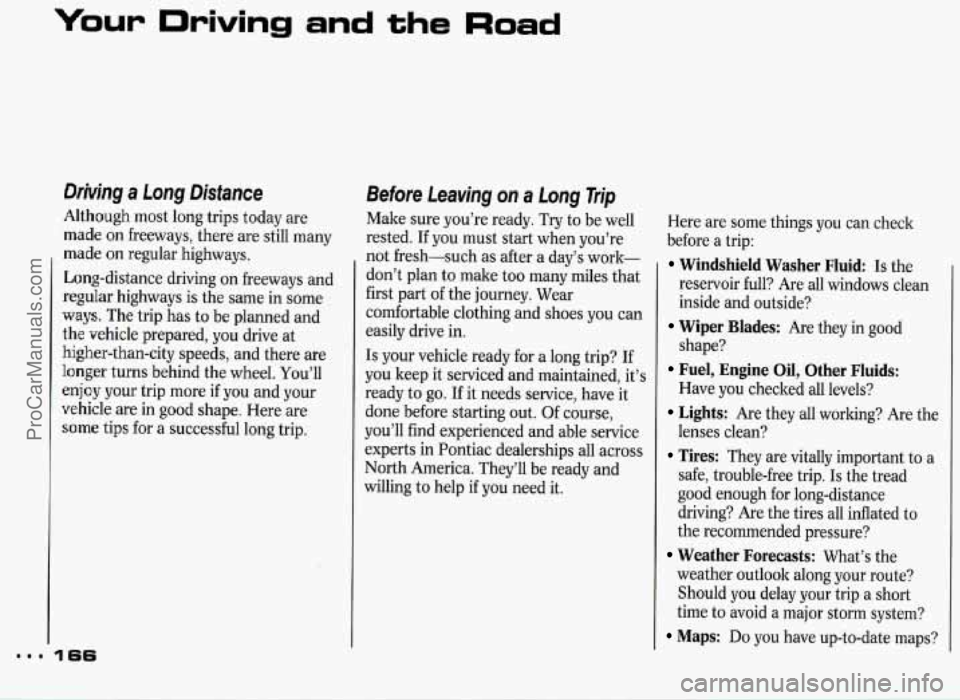1993 PONTIAC GRAND-PRIX check engine light
[x] Cancel search: check engine lightPage 99 of 338

8..
Features & Controls
Low Fuel Warning Light
If your fuel is low, a light will come on.
98
The warning will not go off until you
add fuel. It will also come on for a few
seconds when
you first turn on the
ignition as a check to show you it is
working. If it doesn’t come on then,
have it fixed.
Engine Coolant Temperature Warning Light
This light tells you that your engine
coolant has overheated or your radiator
cooling fan is not working. If you have
been operating your vehicle under
normal driving conditions, you should
pull off the road, stop your vehicle and
turn the engine off
as soon as possible.
HOT
COOLANT CAN BURN YOU
BADLY!
In Problems on the Road, this manual
shows what to do.
See the Index under
Engine Overheating.
ProCarManuals.com
Page 101 of 338

mmm
Features & Controls
I
Oil Warning Light
If you have a problem with your oil, this
light may stay on after you start
your
engine, or come on when you are
driving. This indicates that oil
is not
going through your engine quickly
enough to
keep it lubricated. The
engine
could be low on oil, or could
have some other oil problem. Have it
fixed right away.
3 00
The oil light could also come on in three
other situations:
When the ignition is but the engine
is not running, the light will come on
as a test to show you it is working,
but the light
will go out when you
turn the ignition to Start. If it doesn’t
come on with the ignition on, you
may have a problem with the fuse or
bulb.
Have it fixed right away.
Sometimes when the engine is idling
at
a stop, the light may blink on and
off. This is normal.
If you make a hard stop, the light may
come on for ‘a moment. This is
normal.
Don’t keep driving if the oil
pressure is low. If you do,
your engine can become so hot that
it catches he. You or others could
be burned. Check your oil as soon
as possible and have yaw vehicle
NOTICE
ProCarManuals.com
Page 102 of 338

Oil Pressure Indicator (OPTION)
This indicator tells you if there could be
a problem with your engine oil pressure.
The pointer should be above the red
zone when the engine is running.
I CAUTION
Readings in the red area tell you that
the engine is low on oil, or that you
might have some other oil problem. See
the
Index under Engine Oil.
Don't keep driving if the oil
pressure is low.
If you do,
your engine can become
so hot that
it catches fire, You or others could
be burned. Check your oil as soon
as possible and have your vehicle
serviced.
Battery Warning Light
The charging system light will come on
briefly when you turn on the ignition
as
a check to show you it is working. Then
it should go out.
If it stays on, or comes
on while you are driving, you may have
a problem with the electrical charging
system. It could indicate that
you have
a loose generator drive belt
or another
electrical problem. Have it checked
right away. Driving while this light
is on
could drain your battery.
If you must drive a short distance with
the light
on, be certain to turn off all
your accessories, such as the radio and
air conditioner.
101
ProCarManuals.com
Page 105 of 338

Features & Controls
Malfunction Incfkator Lamp
(Semite Engine Soon Light)
A computer monitors operation of your
fuel, ignition and emission control
systems. This light should
come on
when the ignition is on, but the engine
is not running, as a check to show you
it is,
working. If it does not come on at
all, have it fixed right away. If it stays
on, or it comes on while you are driving,
the computer is indicating that yo8u
have a problem. You should take your
vehicle in for service soon.
If you keep driving your vehicle
with
this light on, after a while th
emission controls won't work as
well, your fuel economy won't be
as good and your engine may not
run as smoothly. This could lead to
costly repai+p@,cqered
by your warranty :',~: ~;'='-- ~ -'--:< .:-
Check Gauges Light (OPTION)
The CHECK GAUGES light will come
on
if your oil pressure gage or engine
coolant temperature gage
is pointing to
the red area.
If these gages do not indicate a
problem, the CHECK GAUGES light
means there is
a problem with your
vehicle's charging system.
ProCarManuals.com
Page 167 of 338

Your Driving and the Road
Drkjng a Long Distance
Although most long trips today are
made on freeways, there are still many
made
on regular highways.
Long-distance driving on freeways and
reguIar highways is the same in some
ways. The trip has to be planned and
the vehicle prepared, you drive at
higher-than-city speeds, and there are
longer turns behind the wheel. You’ll
enjoy your trip more if you and your
vehicle are in good shape. Here are
some tips for a successful long trip.
Before Leaving on a Long Trip
Make sure you’re ready. Try to be well
rested. If you must start when you’re
not fresh-such as after a day’s work-
don’t plan to make too many miles that
first part of the journey. Wear
comfortable clothing and shoes you can
easily drive in.
Is your vehicle ready for a long trip? If
you keep it serviced and maintained, it’s
ready to go. If it needs service, have it
done before starting out. Of course,
you’ll find experienced and able service
experts in Pontiac dealerships all across
North America. They’ll be ready and
willing to help
if you need it. Here
are some things you can check
before a trip:
Windshield Washer Fluid Is the
reservoir full? Are all windows clean
inside and outside?
shape?
Have you checked all levels?
lenses clean? safe, trouble-free trip.
Is the tread
good enough for long-distance
driving? Are the tires all inflated to
the recommended pressure?
weather outlook along your route?
Should
you delay your trip a short
time to avoid a major storm system?
Maps: Do you have up-to-date maps?
Wiper Blades: Are they in good
Fuel, Engine Oil, Other Fluids:
Lights: Are they all working? Are the
Tires: They are vitally important to a
Weather Forecasts: What’s the
ProCarManuals.com
Page 168 of 338

On the Road
Unless you are the only driver, it is good
to share the driving task with others.
Limit turns behind the wheel to about
100 miles (160 lm) or two hours at a
sitting. Then, either change drivers or
stop for some refreshment like coffee,
tea or soft drinks and some limbering
up. But do stop and move around. Eat
lightly along the way. Heavier meals
tend to make some people sleepy.
On two-lane highways or undivided
multilane highways that do not have
controlled access, you’ll want to watch
for some situations not usually found
on freeways. Examples are: stop signs
and signals, shopping centers with
direct access to the highway, no passing
zones and school zones, vehicles
turning left and right off the road,
pedestrians, cyclists, parked vehicles,
and even animals.
Highway Hypnosis
Is there actually such a condition as
“highway hypnosis”? Or is
it just plain
falling asleep at the wheel? Call it
highway hypnosis, lack of awareness,
or
whatever.
There is something about an easy
stretch of road with the same scenery,
along with the hum of the tires
on the
road, the drone of the engine, and the
rush of the wind against the vehicle that
can make you sleepy. Don’t let it
happen to you! If it does, your vehicle
can leave the road in
less than a
second, and you could crash and be
injured.
What can you
do about highway
hypnosis? First, be aware that it can
happen.
Then here are some tips:
Make sure your vehicle is well
ventilated, with a comfortably cool
interior.
Keep your eyes moving. Scan the road
ahead
and to the sides. Check your
rearview mirrors frequently and your
instruments from time to time. This
can help you avoid a fixed stare.
Wear good sunglasses in bright light.
Glare can
cause drowsiness. But don’t
wear sunglasses at night. They will
drastically reduce your overall vision
at the very time
you need all the
seeing power
you have.
If you get sleepy, pull off the road into
a rest, service, or parking area and
take a nap, get some exercise, or both.
For
safety, treat drowsiness on the
highway as
an emergency.
As in any driving situation, keep pace
with traffic and allow adequate
following distances.
ProCarManuals.com
Page 181 of 338

Your Driving and the Road
Driving with a Trailer (CONT.)
Making Turns
When you’re turning with a trailer,
make wider turns than normal. Do this
so your trailer won’t strike soft
sh’oulders, curbs, road signs, trees, or
other objects. Avoid jerky or sudden
maneuvers. Signal well in advance.
Turn Signals When Towing a Trailer
When you tow a trailer, your vehicle has
to have a different turn signal flasher
and extra wiring. The green arrows on
your instrument panel will flash
whenever you signal
a turn or lane
change. Properly hooked
up, the trailer
lights will also flash, telling other
drivers you’re about to turn, change
lanes or stop.
When towing a trailer, the green arrows
on your instrument panel will flash for
turns even if the bulbs on the trailer are
burned out. Thus, you may think
drivers behind you are seeing your
signal when they are not.
It’s important
to check occasionally
to be sure the
trailer bulbs are still working.
Your vehicle has bulb warning lights.
When you plug trailer lights into your
vehicle’s lighting system, its bulb
warning lights may not let you know if
one of your lights goes out.
So, when
you have trailer lights plugged in, be
sure
to check your vehicle and trailer
lights
from time to time to be sure
they’re all working. Once
you
disconnect the trailer lights, the bulb
warning lights again can tell you if one
of your vehicle lights is out.
Driving On Grades
Reduce speed and shift to a lower gear
before you start down a long or steep
downgrade.
If you don’t shift down, you
might have to use your brakes so much
that they would get hot and
no longer
work well.
On a long uphill grade, shift down and
reduce your speed to around
45 mph
(70 kwh) to reduce the possibility of
engine and transaxle overheating.
If you are towing a trailer and you have
an automatic transaxle with Overdrive,
it’s best to drive in
D instead of (or
as you need to, a lower gear). This will
minimize heat build-up and extend the
life of your transaxle.
ProCarManuals.com
Page 188 of 338

A Using a match near a battery I
I can cause battery ga
explode. People have been nurI
doing this, and some have been
blinded. Use a flashlight
if vou nccL
more light.
Be sure the
ua enougn
you accidentally get it in your e
or
on your skin, flush the place
with water and get medical help
immediately.
? ih. w-m I
5. Check that the jumper cables don’t
have loose or missing insulation. If
they do, you could get a shock. The
vehicles could be damaged, too.
engine part. Don’t connect
(+) to (-) or
you’ll get a short that would damage the
battery and maybe other parts, too.
Before you
connect the cables, here are
water.
You doll L IIGW to addware some things you should know. Positive
to the Delco Freedom@ battery
(+) will go to positive (+) and negative
installed in every new
GM vehicle (-) will go to negative (-) or a metal
But if a battery has filler caps, b
sure the right amount of fluid is
there.
If it is low,-add water to t
care of that first.
If you don’t,
explosive gas could be present.
Batte-ry fluid contains acid that
burn
you. Don’t get it on you. I
PA/ ITION I
A
Fans or other moving engine
parts can injure you badly.
Keep your hands away from
moving parts once the engines are
runnin-
6. Connect the red positive (+) cable to
the positive
(+) terminal of the
vehicle with the dead battery. Use a
remote positive
(+) terminal if the
vehicle has one.
ProCarManuals.com